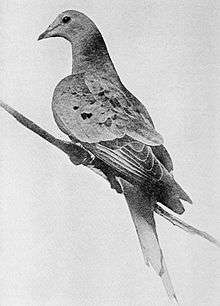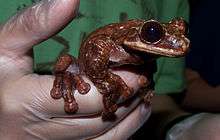Endling

An endling is an individual that is the last of its species or subspecies. Once the endling dies, the species becomes extinct. The word was coined in correspondence in the scientific journal Nature. Alternative names put forth for the last individual of its kind include ender and terminarch. The word relict may also be used but usually refers to a group that is the last of the species.[1]
Use
The 4 April 1996, issue of Nature published a correspondence in which commentators suggested that a new word, endling, be adopted to denote the last individual of a species.[1][2] The 23 May issue of Nature published several counter-suggestions, including ender, terminarch, and relict.[1][3]
The word endling appeared on the walls of the National Museum of Australia in Tangled Destinies, a 2001 exhibition by Matt Kirchman and Scott Guerin about the relationship between Australian peoples and their land. In the exhibition, the definition, as it appeared in Nature, was printed in large letters on the wall above two specimens of the extinct Tasmanian tiger: “Endling (n.) The last surviving individual of a species of animal or plant.” A printed description of this exhibition offered a similar definition, omitting reference to plants: "An endling is the name given to an animal that is the last of its species."[4][5]
In The flight of the emu: a hundred years of Australian ornithology 1901-2001, author Libby Robin states that "the very last individual of a species" is "what scientists refer to as an 'endling'".[6]
In 2011, the word was used in the Earth Island Journal, in an essay by Eric Freedman entitled Extinction is Forever: A Quest for the Last Known Survivors. Freedman defined endling as "the last known specimen of her species."[7]
As of 2016, the word does not appear in the Merriam-Webster Dictionary or the Oxford English Dictionary.
Response
In The sense of an endling, author Helen Lewis describes the notion of an endling as poignant, and the word as "wonderfully Tolkien-esque".[8]
In Cut from history, author Eric Freedman describes endling as "a word with finality." He opines, "It is deep-to-the-bone chilling to know the exact date a species disappeared from Earth. It is even more ghastly to look upon the place where it happened and know that nobody knew or cared at the time what had transpired and why."[9]
Notable examples

This is not a comprehensive list of contemporary extinction, but a list of high-profile, widely publicised examples of when the last individual of a species was known.
The last great auks were killed in 1852 for specimen collectors, after many centuries of exploitation for meat, eggs and oil for burning.
The quagga (Equus quagga quagga) became extinct in the wild in the late 1870s due to hunting for meat and skins, and the subspecies' endling died in captivity on 12 August 1883 at the Artis in Amsterdam.
The passenger pigeon (Ectopistes migratorius) became extinct on 1 September 1914, when the endling Martha died at the Cincinnati Zoo.[10][11] Once hugely abundant, millions of other passenger pigeons were threatened by habitat loss and later eradicated by hunting.
Incas, the last Carolina parakeet (Conuropsis carolinensis), died at the Cincinnati Zoo on 21 February 1918.[11]
Booming Ben, a solitary heath hen (Tympanuchus cupido cupido), was last seen 11 March 1932 on Martha's Vineyard, Massachusetts.[12]
On 7 September 1936, Benjamin, the last Tasmanian tiger (Thylacinus cynocephalus) died in Hobart Zoo, after the species was persecuted by farmers to extinction in the wild. It has been suggested Benjamin died of neglect during a night of unusually extreme weather conditions in Tasmania.[13]
The last Kauaʻi ʻōʻō was a male, and its song was recorded for the Cornell Lab of Ornithology's Bioacoustics Research Program. The male was recorded singing a mating call, to a female that would never come. It died in 1987.
Orange Band was the last Dusky seaside sparrow who died on 16 June 1987.[14]
Turgi was the last Partula turgida, a Polynesian tree snail, who died on 31 January 1996 in the London Zoo.[15]
Celia, the last Pyrenean ibex (Capra pyrenaica pyrenaica), was found dead on 6 January 2000 in the Spanish Pyrenees, after hunting and competition from livestock reduced the population to one individual.[16]
On 24 June 2012, Lonesome George, who was the last known Pinta Island tortoise (Chelonoidis nigra abingdonii), died in his habitat in the Galápagos Islands.[17]
A tank in the Bristol Zoo was the last refuge of Partula faba, a land snail from Ra'iātea in French Polynesia. The population dropped from 38 in 2012[18] to one in 2015.[19] The last individual died on 21 February 2016.[19]
Until September 26, 2016, the Atlanta Botanical Garden was home to last known surviving Rabbs' fringe-limbed treefrog (Ecnomiohyla rabborum) named Toughie. All others were killed by the fungal infection Chytridiomycosis, which is driving amphibians worldwide to extinction.

Potential endlings
The University of Hawai'i has, in captivity, the last known individual of the snail species Achatinella apexfulva. No other members of this species have been found in over a decade of searching.[20]
The very last wild group (or 'relict') of Panamanian golden frogs were taken into captivity in 2006 to prevent their deaths from Chytridiomycosis infection, and the last Golden toad was seen in 1989.
See also
- Extinction
- Holocene extinction
- Anthropocene
- Rare species
- Conservation status
- Lists of extinct animals
- Rememberer
- List of neologisms
- The Last of the Mohicans
- Last Man
References
- 1 2 3 Jorgensen, Dolly (13 April 2013). "Naming and claiming the last". Retrieved 26 January 2014.
- ↑ Robert M. Webster & Bruce Erickson (4 April 1996). "The last word?". Nature. 380 (386). doi:10.1038/380386c0.
- ↑ Elaine Andrews (4 April 1996). "The last word". Nature. 381 (272). doi:10.1038/381272d0.
- ↑ "Tangled Destinies" (PDF). National Museum of Australia. 2002. Retrieved 27 January 2014.
- ↑ Smith, Mike (2001). "The Endling exhibition, Tangled Destinies gallery, National Museum of Australia, Canberra, 2001" (PDF). National Museum of Australia. Retrieved 27 January 2014.
- ↑ Robin, Libby (2002). The flight of the emu: a hundred years of Australian ornithology 1901-2001. Melbourne University Press. p. 260. ISBN 978-0522849875.
- ↑ Freedman, Eric (2011). "Extinction is Forever: A Quest for the Last Known Survivors". Earth Island Journal. Retrieved 27 January 2014.
- ↑ Lewis, Helen (27 June 2012). "Sense of an endling". The New Statesman. Retrieved 30 January 2014.
- ↑ Freedman, Eric (5 July 2008). "Cut from history: An abandoned Tasmanian zoo tells the haunting tale of an ending". EJ Magazine. Archived from the original on 2008-07-05. Retrieved 30 January 2014.
- ↑ "Endangered Species Handbook" (pdf). Animal Welfare Institute. 1983. Retrieved 29 February 2012.
- 1 2 Blythe, Anne (27 August 2012). "Extinct Carolina Parakeet still fascinates". www.newsobserver.com. Retrieved 27 January 2014.
- ↑ "Heath Hen (Extinct)". BeautyOfBirds (formerly Avian Web). Retrieved 27 January 2014.
- ↑ Lewis, Robert; Arnold, David (2002). "Tangled Destinies: Exploring land and people in Australia over time through the National Museum of Australia" (PDF). ISBN 0-949380-41-5. Archived from the original (PDF) on July 2011.
- ↑ "Last of dusky sparrows dies". The New York Times. Associated Press. 17 June 1987.
- ↑ "Tiny Tree Snail Finally Creeps To Extinction". Chicago Tribune. 1 February 1996.
- ↑ Richard Gray and Roger Dobson (31 January 2009). "Extinct ibex is resurrected by cloning". The Telegraph. Retrieved 27 January 2014.
- ↑ Valencia, Alexandra; Garcia, Eduardo (24 June 2012). "Lonesome George, last-of-his-kind Galapagos tortoise, dies". Reuters.
- ↑ Five of the world's 10 most at-risk species at Bristol Zoo
- 1 2 Island Bioldiversity Patula faba
- ↑ van Dooren, Thom. "The last snail: conservation and extinction in Hawai'i". http://thomvandooren.org/2013/02/28/last_snail/. Retrieved 2014-06-01. External link in
|website=(help)
External links
- Cut from history by Eric Freedman for Knight Center for Environmental Journalism
- Bringing Them Back to Life by Carl Zimmer for National Geographic Magazine.
